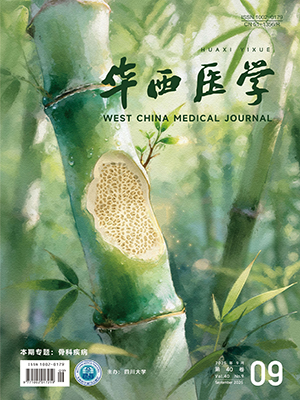| 1. |
黄洁, 李玛琳, 孙敏, 等. 梗阻性黄疸患者胆汁微生物群落限制性片段多态性分析. 中华实验外科杂志, 2014, 31(11): 2396-2398.
|
| 2. |
Yokoe M, Hata J, Takada T, et al. Tokyo guidelines 2018: diagnostic criteria and severity grading of acute cholecystitis (with videos). J Hepatobiliary Pancreat Sci, 2018, 25(1): 41-54.
|
| 3. |
高戈, 冯喆. 外科脓毒症及脓毒性休克现状与展望. 中华实验外科杂志, 2015, 32(2): 232-234.
|
| 4. |
Lüebbert C, Wendt K, Feisthammel J, et al. Epidemiology and resistance patterns of bacterial and fungal colonization of biliary plastic stents: a prospective cohort study. PLoS One, 2016, 11(5): e0155479.
|
| 5. |
中华医学会外科学分会胆道外科学组. 急性胆道系统感染的诊断和治疗指南 (2011 版).中华消化外科杂志, 2011, 10(1): 9-13.
|
| 6. |
Park JW, Lee JK, Lee KT, et al. How to interpret the bile culture results of patients with biliary tract infections. Clin Res Hepatol Gastroenterol, 2014, 38(3): 300-309.
|
| 7. |
黄勋, 邓子德, 倪语星, 等. 多重耐药菌医院感染预防与控制中国专家共识. 中国感染控制杂志, 2015, 14(1): 1-9.
|
| 8. |
Bornscheuer T, Schmiedel S. Calculated antibiosis of acute cholangitis and cholecystitis. Viszeralmedizin. 2014, 30(5): 297-302.
|
| 9. |
王秋霞. 胆道感染人群胆汁中细菌最新分布情况及对抗菌素敏感性的变化分析. 河北医药, 2017, 39(6): 945-946.
|
| 10. |
王志刚, 潘乐玉, 徐金莲, 等. 胆道感染致病菌分布及耐药性的研究. 中华实验外科杂志, 2015, 32(8): 1973-1975.
|
| 11. |
孙志, 王鹏远, 李威, 等. 2012 年全国三级医院胆汁培养病原菌的构成及耐药性分析. 中国临床药理学杂志, 2015, 31(11): 1038-1041.
|
| 12. |
周春妹, 胡必杰, 吕媛. 卫生部全国细菌耐药监测网 2011 年胆汁培养病原菌耐药监测. 中国临床药理学杂志, 2012, 28(12): 933-936.
|
| 13. |
吕骅, 朱明炜, 牛小娟, 等. 外科胆道感染病原菌单中心 30 年变迁. 中华肝胆外科杂志, 2016, 22(9): 611-613.
|
| 14. |
李儒, 刘波, 张卫红, 等. 2013-2015 年微生物培养中无菌标本送检情况分析. 南京医科大学学报: 自然科学版, 2017, 37(3): 332-334.
|
| 15. |
Weber A, Huber W, kamereck K, et al. In vitro activity of moxifloxacin and piperacillin/ sulbactam against pathogens of acute cholangitis. World J Gastroenterol, 2008, 14(20): 3174-3178.
|
| 16. |
Kochar R, Banerjee S. Infections of the biliary tract. Gastrointest Endosc Clin N Am, 2013, 23(2): 199-218.
|
| 17. |
Yu H, Guo Z, Xing W, et al. Bile culture and susceptibility testing of malignant biliary obstruction via PTBD. Cardiovasc Intervent Radiol, 2012, 35(5): 1136-1144.
|
| 18. |
邹雪飞, 吴广利, 王伟, 等. 胆石症合并急性胆管炎患者胆汁及血液病原菌培养及药敏分析. 中华实验和临床感染病杂志: 电子版, 2015, 9(1): 91-95.
|
| 19. |
Horan TC, Andrus M, Dudeck MA. CDC/NHSN surveillance definition of health care-associated infection and criteria for specific types of infections in the acute care setting. Am J Infect Control, 2008, 36(5): 309-332.
|
| 20. |
Weinstein MP, Doern GV. A critical appraisal of the role of the clinical microbiology laboratory in the diagnosis of bloodstream infections. J Clin Microbiol, 2011, 49(9 Suppl): S26-S29.
|
| 21. |
《抗菌药物临床应用指导原则》修订工作组. 抗菌药物临床应用指导原则 (2015 年版). 北京: 人民卫生出版社, 2015.
|




